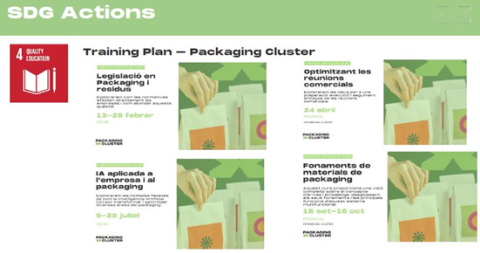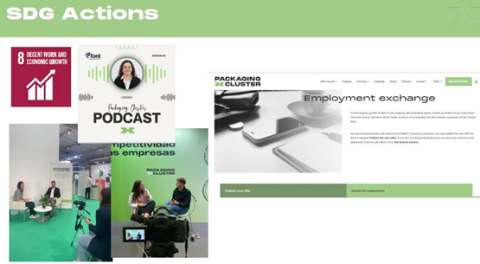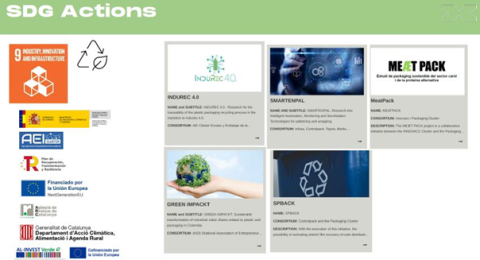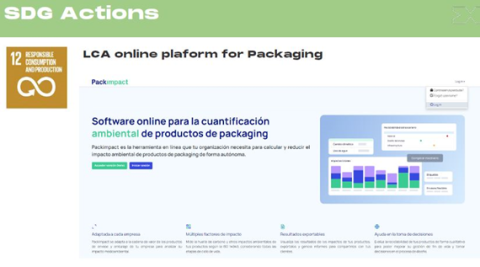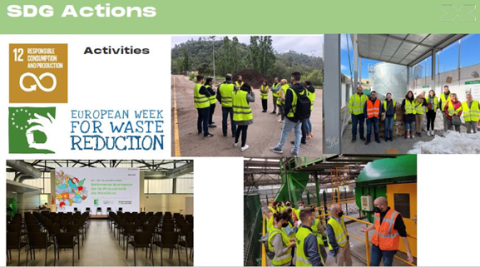How clusters deal with SDGs: The Catalan Packaging cluster
Quality Education (SDG 4)
Problem Addressed and Context:
The packaging sector in Catalonia lacks adequate training programs focusing on the technical aspects of the packaging industry. This gap in education impedes the development of business competencies and the enhancement of workers' knowledge within the packaging ecosystem.
Implementation and Objectives:
To address this problem, specific and short training programs have been introduced. These programs aim to improve business competencies and increase workers' knowledge in the packaging ecosystem. The approach involves developing and offering specialized courses tailored to the technical needs of the packaging industry. By doing so, workers gain relevant skills and expertise, which in turn enhances their performance and the overall quality of the sector.
Stakeholders and Beneficiaries:
The main stakeholders include educational institutions, industry professionals, and companies within the packaging sector. The primary beneficiaries are the workers in the packaging ecosystem who receive the training, as well as the companies that benefit from a more skilled workforce.
Decent Work and Economic Growth (SDG 8)
Problem Addressed and Context:
There is a need to promote communication and knowledge among young people about the packaging sector, improve the sector's image, and open up job opportunities.
Implementation and Objectives:
The practice involves promoting the packaging sector to young people through various channels such as podcasts, presentations, and social media. By enhancing the sector's image and highlighting job opportunities, the initiative aims to attract young talent and foster economic growth within the sector.
Stakeholders and Beneficiaries:
Key stakeholders include educational institutions, youth organizations, industry associations, and media outlets. The main beneficiaries are young people who gain awareness of career opportunities in the packaging sector and the industry itself, which benefits from a rejuvenated workforce.
Industry, Innovation, and Infrastructure (SDG 9)
Problem Addressed and Context:
There is a need to improve companies' competitiveness by incorporating technology and digitizing production processes. Additionally, securing public funding for sustainable innovations is crucial.
Implementation and Objectives:
The practice involves undertaking projects that integrate technology and digital solutions into production processes. By doing so, companies can enhance their competitiveness. Additionally, efforts are made to secure public funding to support sustainable innovations, ensuring long-term industry growth and development.
Stakeholders and Beneficiaries:
The main stakeholders are companies within the packaging sector, technology providers, and public funding bodies. Beneficiaries include the companies that gain competitive advantages and the broader community that benefits from sustainable industry practices.
Responsible Consumption and Production (SDG 12)
Problem Addressed and Context:
There is a need for companies to improve their packaging by considering its use and end-of-life, promoting eco-design strategies, and conducting life cycle analyses.
Implementation and Objectives:
The Packimpact tool is utilized to help companies perform life cycle analyses of their packaging. This practice promotes responsible consumption and production by encouraging eco-design strategies that consider the entire lifecycle of packaging, from creation to disposal.
Stakeholders and Beneficiaries:
Stakeholders include packaging companies, environmental organizations, and consumers. Beneficiaries are the companies that improve their packaging practices and the environment, which benefits from reduced waste and more sustainable packaging solutions.
Partnerships for the Goals (SDG 17)
Problem Addressed and Context:
There is a need to implement European packaging legislation and promote initiatives that support ecological transition objectives.
Implementation and Objectives:
The Value for Pack project involves collaboration with various stakeholders to implement European packaging legislation. This partnership promotes initiatives aimed at achieving ecological transition objectives, ensuring that the packaging sector aligns with sustainability goals.
Stakeholders and Beneficiaries:
The main stakeholders are regulatory bodies, packaging companies, environmental organizations, and industry associations. The beneficiaries include the packaging sector, which aligns with regulatory requirements, and the environment, which benefits from more sustainable packaging practices.
Resources needed:
The resources are covered by the cluster's annual budget sourced from member fees, public funding for projects, and revenue from other services offered to the ecosystem. The integrated approach ensures that the initiatives are sustainable and effectively leverage the collective resources and knowledge of the cluster.

